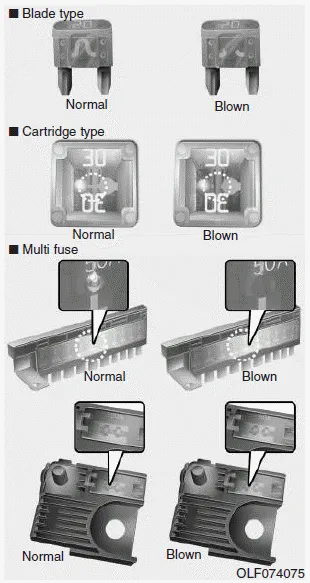Hyundai i30 (PD): Maintenance / Fuses

A vehicle’s electrical system is protected from electrical overload damage by fuses.
This vehicle has 2 (or 3) fuse panels, one located in the driver’s side panel bolster, the other in the engine compartment.
If any of your vehicle’s lights, accessories, or controls do not work, check the appropriate circuit fuse. If a fuse has blown, the element inside the fuse will be melted or broken.
If the electrical system does not work, first check the driver’s side fuse panel. Before replacing a blown fuse, turn the engine and all switches off, and then disconnect the negative battery cable. Always replace a blown fuse with one of the same rating.
If the replacement fuse blows, this indicates an electrical problem. Avoid using the system involved and immediately consult a HYUNDAI authorised repairer.
Information
Three kinds of fuses are used: blade type for lower amperage rating, cartridge type, and multi fuse for higher amperage ratings.
WARNING
NEVER replace a fuse with anything but another fuse of the same rating.
- A higher capacity fuse could cause damage and possibly cause a fire.
- Do not install a wire or aluminium foil instead of the proper fuse - even as a temporary repair. It may cause extensive wiring damage and possibly a fire.
NOTICE
Do not use a screwdriver or any other metal object to remove fuses because it may cause a short circuit and damage the system.
- Instrument panel fuse replacement
- Engine compartment panel fuse replacement
- Fuse/Relay panel description
A low aspect ratio tyre, of which the aspect ratio is lower than 50, is designed for a sporty-look vehicle. The low aspect ratio is to optimize handling and braking.
1. Turn the vehicle off. 2. Turn all other switches OFF. 3. Open the fuse panel cover. 4. Refer to the label on the inside of the fuse panel cover to locate the suspected fuse location.
Other information:
Hyundai i30 (PD) 2018-2024 Owner's Manual: Checking the engine oil and filter
We recommend that the engine oil and filter be replaced by a HYUNDAI authorised repairer. WARNING Used engine oil may cause irritation or cancer of the skin if left in contact with the skin for prolonged periods of time. Used engine oil contains chemicals that have caused cancer in laboratory animals.
Hyundai i30 (PD) 2018-2024 Owner's Manual: Emission control system
The emission control system of your vehicle is covered by a written limited warranty. Please see the warranty information contained in the Warranty Booklet in your vehicle. Your vehicle is equipped with an emission control system to meet all applicable emission regulations.
Categories
- Manuals Home
- Hyundai i30 Owners Manual
- Engine compartment
- Engine coolant
- Brake/clutch fluid
- New on site
- Most important about car
